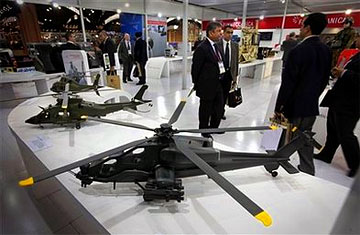
Scale models of helicopters are on display at Defexpo 2010 in New Delhi on Feb. 16, 2010
The Indian Defense Minister, A.K. Antony, called this week's massive defense-industry trade show, Defexpo 2010, "an endeavor to showcase India's capabilities in land and naval systems as well as its emergence as an attractive destination for investment in the defense sector." His junior minister, M.M. Pallam Raju, was a little more blunt. He called the event, which attracted more than 600 companies from 35 countries, a "one-stop shop." India is emerging as one of the most important defense markets in the world, with billions of dollars to spend, and the global defense industry is only too happy to help it do so.
The country's marquee bid is an order for 126 fighter planes, worth $10 billion — the single biggest tender in the world in the past 15 years. Six companies' jets are in the running: Boeing's F/A-18 E/F Super Hornet, Dassault Aviation's Rafale, Lockheed Martin's F-16, Russia's MiG-35, Saab's JAS 39 Gripen and the Eurofighter Typhoon from EADS, a six-nation European consortium. All of them sent teams of delegates to Defexpo. They hovered around their booths, giving impromptu presentations over free cappuccino to bureaucrats, army officers and local journalists. The bid is already in its final stages — Indian air force pilots are testing the planes in the field — so it is unlikely that the PowerPoint slides at Defexpo will sway the decision. Still, says Marco Bonelli, spokesman for the Eurofighter Typhoon, "you have to be here."
So it was with no small pride that EADS representatives pointed out that the Defense Minister came to their booth this week and tried out the Eurofighter Typhoon flight simulator. He sat in a replica of the cockpit, watching a head-up display projected onto a screen in front of him as a simulated landscape — in this case, the west of England, near Manchester — passed underneath. Wing Commander Anthony (Foxy) Gregory of the Royal Air Force was there to answer technical questions, and will head to Bangalore to work with Indian test pilots. "We see the Indian air force becoming a strategic partner in the region," Gregory says.
What has really drawn defense companies to India, however, is the smaller-ticket market for internal security, especially after the Nov. 26, 2008, terrorism attacks in Mumbai. "We had to rethink our strategy after 26/11," says Woolf Gross, corporate director of international programs for Northrop Grumman. "After our review, we decided to cater to India's homeland security." The company adapted one of its surveillance systems, for example, to identify suspicious vehicles at sea, the route that the Mumbai attackers are believed to have used. For the first time since the inaugural Defexpo in Delhi in 1999, Northrop Grumman has flown in representatives from all five of its units. "We are hoping for that one big sale in India," he says.
The Indian government, too, has signaled the new importance of what it calls "low-intensity conflict," like the multiagency security offensive aimed at defeating India's armed Maoist insurgency, a movement that controls a wide stretch of territory in central India. The Defense Ministry's research and development arm, which traditionally caters to the needs of the armed forces, displayed this year for the first time unmanned aerial vehicles and other weapons developed for counterinsurgency. "Technology is being dovetailed to suit low-intensity conflicts," a top defense research official told TIME.
U.S. companies are following their lead. Taser, for example, is selling its controversial stun-guns, used by law-enforcement authorities to subdue people, to Indian state police forces as well as central security forces, which are conducting joint anti-Maoist operations. It has already signed contracts for Taser weapons with the police forces of two states — Punjab and Jammu and Kashmir — and expects India to become one of its "top 10, if not top 5," export markets, says spokesman Yogesh Saini. "They're not allowed for private security guards [in India], but we have had people asking about it."
One question left unanswered at Defexpo 2010 was whether a country in which one-third of the adults are illiterate and 43% of children are malnourished should spend so much on weapons. India's central government spent $4.5 billion on education in 2008 — about the same amount that it plans to spend on 197 new helicopters. A handful of protesters picketed outside the gates of the exhibition hall on opening day, but they drew little notice. India's attention is firmly focused on what a defense-company representative called the "quality gap" between its weapons and those of its neighbors, Pakistan and China. The gaps at home will have to wait.
